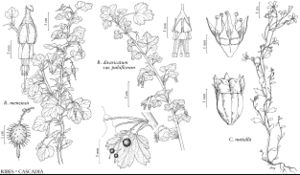Difference between revisions of "Ribes divaricatum"
Trans. Hort. Soc. London 7: 515. 1830 ,.
FNA>Volume Importer |
RevisionBot (talk | contribs) m (Bot: Adding category Revised Since Print) |
||
| (4 intermediate revisions by 3 users not shown) | |||
| Line 7: | Line 7: | ||
}} | }} | ||
|common_names=Straggly gooseberry | |common_names=Straggly gooseberry | ||
| + | |special_status={{Treatment/ID/Special_status | ||
| + | |code=F | ||
| + | |label=Illustrated | ||
| + | }}{{Treatment/ID/Special_status | ||
| + | |code=E | ||
| + | |label=Endemic | ||
| + | }} | ||
|basionyms= | |basionyms= | ||
|synonyms={{Treatment/ID/Synonym | |synonyms={{Treatment/ID/Synonym | ||
| Line 23: | Line 30: | ||
-->{{Treatment/Body | -->{{Treatment/Body | ||
| − | |distribution= | + | |distribution=B.C.;Calif.;Oreg.;Wash. |
|discussion=<p>Varieties 3 (3 in the flora).</p><!-- | |discussion=<p>Varieties 3 (3 in the flora).</p><!-- | ||
--><p>Hybrids between <i>Ribes divaricatum</i> and <i>R. niveum</i> and <i>R. divaricatum</i> and <i>R. lobbii</i> have been propagated for the horticultural trade.</p> | --><p>Hybrids between <i>Ribes divaricatum</i> and <i>R. niveum</i> and <i>R. divaricatum</i> and <i>R. lobbii</i> have been propagated for the horticultural trade.</p> | ||
| Line 62: | Line 69: | ||
|basionyms= | |basionyms= | ||
|family=Grossulariaceae | |family=Grossulariaceae | ||
| − | |distribution= | + | |distribution=B.C.;Calif.;Oreg.;Wash. |
|reference=None | |reference=None | ||
|publication title=Trans. Hort. Soc. London | |publication title=Trans. Hort. Soc. London | ||
|publication year= | |publication year= | ||
| − | |special status= | + | |special status=Illustrated;Endemic |
| − | |source xml=https:// | + | |source xml=https://bitbucket.org/aafc-mbb/fna-data-curation/src/2e0870ddd59836b60bcf96646a41e87ea5a5943a/coarse_grained_fna_xml/V8/V8_71.xml |
|genus=Ribes | |genus=Ribes | ||
|species=Ribes divaricatum | |species=Ribes divaricatum | ||
}}<!-- | }}<!-- | ||
| − | -->[[Category:Treatment]][[Category:Ribes]] | + | --> |
| + | |||
| + | [[Category:Treatment]] | ||
| + | [[Category:Ribes]] | ||
| + | [[Category:Revised Since Print]] | ||
Latest revision as of 18:18, 6 November 2020
Plants 1–3 m. Stems erect to spreading, ± pubescent throughout; spines at nodes absent or 1–3, 5–20 mm; prickles on internodes absent or sparse. Leaves: petiole 1–3 cm, pilose with glandular and eglandular hairs, some plumose hairs at base; blade roundish to nearly reniform, 3- (or 5-)lobed, cleft 1/2 to midrib, proximal segments again shallowly cleft into 2 unequal lobes, 2–3.5 cm, base rounded to cordate, surfaces pubescent abaxially, subglabrous or finely pubescent adaxially, lobes cuneate, margins prominently crenate-serrate, apex rounded. Inflorescences pendent, solitary flowers or 2–4-flowered racemes, 2–4 cm, axis glabrous or pilose, flowers evenly spaced. Pedicels not jointed, 3–12 mm, glabrous or pilose; bracts oval, 1–2 mm, glabrous or ciliate with stiff hairs and glands. Flowers: hypanthium greenish or purplish, obconic, 1.5–3.5 mm, glabrous or copiously pubescent; sepals not overlapping, spreading-reflexed, red or reddish or purplish green, narrowly oblong-deltate, 3.4–6 mm; petals distally nearly connivent to overlapping, erect, white or pink to red, cuneate-lunate to obovate, not conspicuously revolute or inrolled, 1.2–3 mm; nectary disc not prominent; stamens 2.5–3.5 times as long as petals; filaments linear, 3.5–7 mm, glabrous; anthers cream, oval, 1 mm, apex rounded; ovary glabrous; styles connate ca. 1/2 their lengths, 5–11 mm, copiously pilose-villous in proximal 3/4. Berries palatable, purplish black, subglobose, 6–12 mm, glabrous. 2n = 16.
Distribution

B.C., Calif., Oreg., Wash.
Discussion
Varieties 3 (3 in the flora).
Hybrids between Ribes divaricatum and R. niveum and R. divaricatum and R. lobbii have been propagated for the horticultural trade.
Selected References
None.
Lower Taxa
Key
| 1 | Petals 1.2-1.7 mm, white; styles 5-7 mm; fila- ments 3.5-4.7(-5) mm. | Ribes divaricatum var. pubiflorum |
| 1 | Petals 2-3 mm, white or pink to red; styles 8-11 mm; filaments 4.5-7 mm | > 2 |
| 2 | Petals white; hypanthia 1.7-2.5 mm. | Ribes divaricatum var. divaricatum |
| 2 | Petals pink to red; hypanthia 2.8-3.5 mm. | Ribes divaricatum var. parishii |
